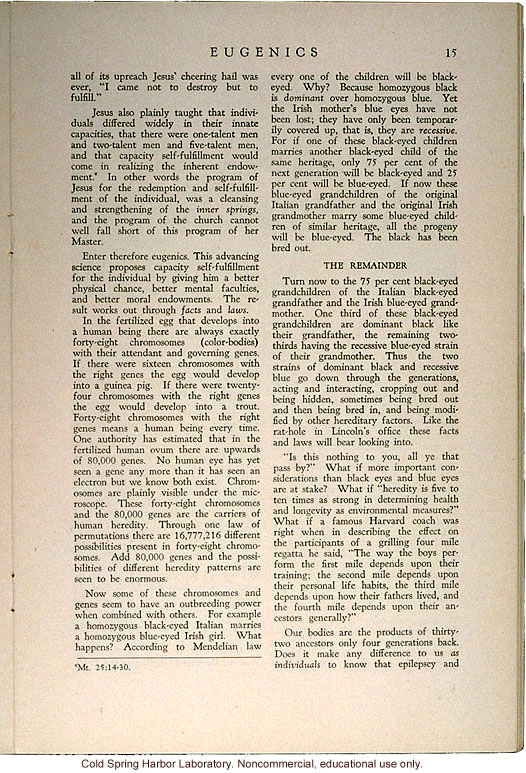Eugenics 15
all of its upreach Jesus' cheering hail was ever, "I come not to destroy but to fulfill."
Jesus also plainly taught that individuals differed widely in their innate capacities, that there were one-talent men and two-talent men and five-talent men, and that capacity self-fulfillment would come in realizing the inherent endowment.[superior 6] In other words the program of Jesus for the redemption and self-fulfillment of the individual, was a cleansing and strengthening of the [italics]inner springs[end italics], and the program of the church cannot well fall short of this program of her Master.
Enter therefore eugenics. This advancing science proposes capacity self-fulfillment for the individual by giving him a better physical chance, better mental faculties, and better moral endowments. The result works out through [italics]facts[end italics] and [italics]laws[end italics].
In the fertilized egg that develops into a human being there are always exactly forty-eight chromosomes (color bodies) with their attendant and governing genes. If there were sixteen chromosomes with the right genes the egg would develop into a guinea pig. If there were twenty-four chromosomes with the right genes the egg would develop into a trout. Forty-eight chromosomes with the right genes means a human being every time. One authority has estimated that in the fertilized ovum there are upwards of 80,000 genes. No human eye has yet seen a gene any more than it has seen an electron but we know both exist. Chromosomes are plainly visible under the microscope. These forty-eight chromosomes and the 80,000 genes are the carriers of human heredity. Through one law of permutations there are 16,777,216 different possibilities present in forty-eight chromosomes. Add 80,000 genes and the possibilities of different heredity patterns are seen to be enormous.
Now some of these chromosomes and genes seem to have an outbreeding power when combined with others. For example a homozygous black-eyed Italian marries a homozygous blue-eyed Irish girl. What happens? According to Mendelian law every one of the children will be black-eyed. Why? Because homozygous black is [italics]dominant[end italics] over homozygous blue. Yet the Irish mother's blue eyes have not been lost; they have only been temporarily covered up, that is, they are [italics]recessive[end italics]. For if one of these black-eyed children marries another black-eyed child of the same heritage, only 75 per cent of the next generation will be black-eyed and 25 per cent will be blue-eyed. If now these blue-eyed grandchildren of the original Italian grandfather and the original Irish grandmother marry some blue-eyed children of similar heritage, all the progeny will be blue-eyed. The black has been bred out.
The Remainder
Turn now to the 75 per cent black-eyed grandchildren of the Italian black-eyed grandfather and the Irish blue-eyed grandmother. One third of these black-eyed grandchildren are dominant black like their grandfather, the remaining two-thirds having the recessive blue-eyed strain of their grandmother. Thus the two strains of dominant black and recessive blue go down through the generations, acting and interacting, cropping out and being hidden, sometimes being bred out and then being bred in, and being modified by other hereditary factors. Like the rat-hole in Lincoln's office these facts and laws will bear looking into.
"Is this nothing to you, all ye that pass by?" What if more important considerations than black eyes and blue eyes are at stake? What if "heredity is five to ten times as strong in determining health and longevity as environmental measures?" What if a famous Harvard coach was right when in describing the effect on the participants of a grilling four mile regatta he said, "The way the boys perform the first mile depends upon their training; the second mile depends upon their personal life habits, the third mile depends upon how their fathers lived, and the fourth mile depends upon their ancestors generally?"
Our bodies are the products of thirty-two ancestors only four generations back. Does it make any difference to us [italics]as individuals[end italics] to know that epilepsy and
[footnote][superior 6] Mt. 25:14-30.
[end]


